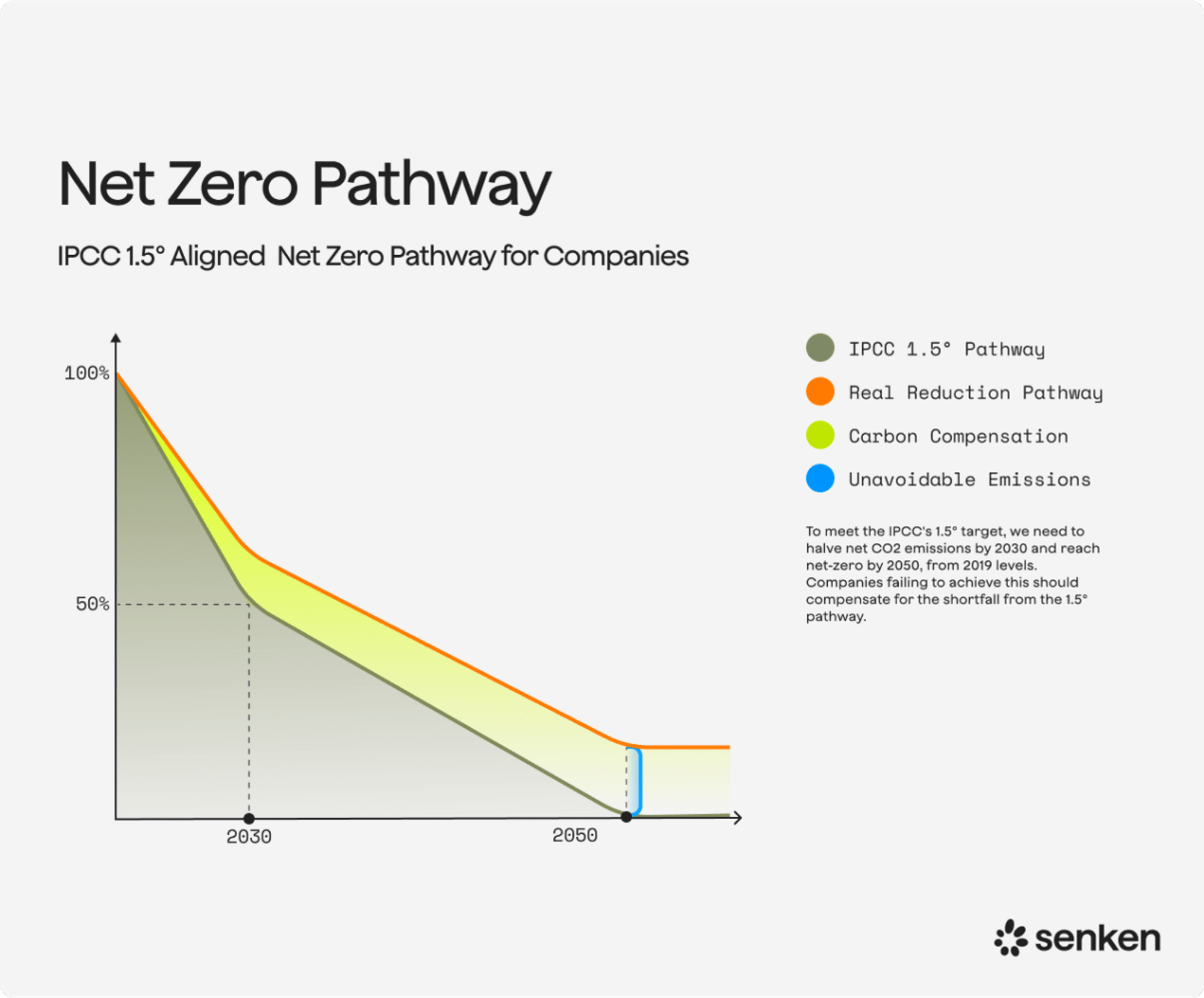In today's world, climate change has become a critical concern for companies of all sizes, especially in Germany, Europe's biggest emitter, where the pursuit of net zero emissions has taken centre stage since the government committed to reaching net zero emissions by 2045.
This chapter goes deeper into the key parts of the net zero journey, specifically for companies, such as the IPCC pathway, the mitigation hierarchy, the net zero pathway for companies, and how to get started.
What does net zero mean for companies?
As described in the previous chapter, a company is considered to have reached net zero when it has drastically reduced its emissions of carbon dioxide (CO2) and other greenhouse gases (GHGs) to the lowest feasible level, and then compensates for any remaining unavoidable emissions by removing an equivalent amount of GHGs from the atmosphere, achieving a balance between the amount of GHGs emitted and the amount removed.
How do companies achieve net zero?
Simply put, achieving net zero in a company is done via three actions:
- Reduce or avoid direct emissions from a company's operations and supply chain
- Compensate for remaining emissions through purchasing and retiring carbon credits.
- Report by documenting emission reduction initiatives and detailing the use and impact of carbon credits

The next question is how much of each of the first two actions should a company do. The widely accepted best practice (called the Mitigation Hierarchy) is as follows:
- Avoidable or easy-to-remove emissions should be reduced or avoided altogether.
- Neutralise hard-to-remove and unavoidable emissions by purchasing carbon credits.
The generally accepted rule of thumb is that an estimated 5-10% of all a company's emissions will be unavoidable or hard to remove. This helps companies estimate the amount of emissions for which they should be compensated with carbon credits.
How is net zero different from carbon neutral?
These terms are often used interchangeably, but they are two very different commitments.
Carbon Neutral: Committing to counterbalancing all CO2 emissions to zero, but with no requirement to reduce or avoid emissions, meaning the company can counterbalance all CO2 emissions simply by purchasing and retiring carbon credits.
Note: The EU is proposing to ban the use of the term carbon neutral by 2026.
In an attempt to stop consumer products greenwashing, the EU will ban claims such as “climate neutral” or “eco” unless companies can prove their accuracy. The rules are expected to come into force by 2026”. - Carbonherald
Net zero: Committing to eliminating all emissions to zero point, by reducing and avoiding all possible avoidable emissions, only counterbalancing the rest of the hard-to-abate and unavoidable emissions with purchasing and retiring carbon credits.
The net zero pathway for companies
As you can see below, the net zero pathway for companies follows the IPCC 1.5° pathway and achieves it through the combination of real reductions and carbon credit compensation for unavoidable emissions.

Case study: Germany's net zero pathway
Germany, as one of the leading economies and the largest emitter in Europe, has set ambitious goals to achieve net zero emissions by 2045. Understanding the government's commitment to net zero is critical for companies, as they often become required to do things to achieve the government's commitment via legislation. Germany's net zero pathway involves transitioning to renewable energy sources, promoting energy efficiency, and fostering sustainable practices across industries.

How many companies are committing to net zero?
According to Zero Tracker, 929 companies from the Forbes 2000 list have set net zero targets, up from 417 in December 2020, and 702 in June 2022. — Zero Tracker

How to get started? An Overview
Getting started on a net zero journey can feel like an overwhelming task. The most important first steps are to understand your company’s footprint, how to reduce these emissions, and how to incorporate carbon credits to help reach net zero more effectively. Senken has developed free-to-use tools that can guide you in the right direction.
- The Senken AI Scorecard can help you get a rough estimate of your emissions and benchmark against other companies in the same sector. Check your emissions now.
- The Senken Planner can help you to keep track of your actual emissions data, set reduction targets and visualise the impact of carbon credits on your net zero targets. (coming soon).
We will deep dive into this whole process in much more detail in this course!
FAQs
- What is the IPCC pathway, and why is it essential for companies on their net zero journey?
The IPCC pathway provides a scientifically grounded framework for reducing carbon emissions to net zero. It serves as a crucial guide for companies committed to sustainability. - How can sustainability representatives prioritise actions using the mitigation hierarchy?
The mitigation hierarchy helps prioritise actions by emphasising the importance of avoiding emissions, reducing emissions through efficiency, replacing fossil fuels, and offsetting unavoidable emissions. - What are some key milestones on Germany's net zero pathway?
Germany's net zero pathway involves transitioning to renewable energy, enhancing energy efficiency, and fostering sustainability practices in various industries. - Why are statistics on companies setting net zero targets significant?
Monitoring the number of companies committing to net zero goals reflects the growing global awareness and commitment to sustainability. - What additional topics should sustainability representatives consider on the net zero journey?
Sustainability representatives should explore topics such as carbon pricing, stakeholder engagement, innovation, supply chain sustainability, and evolving environmental regulations to enhance their sustainability strategies.
.svg)